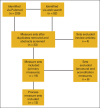Quality measures for palliative care in patients with cancer: a systematic review
- PMID: 24917264
- PMCID: PMC4094644
- DOI: 10.1200/JOP.2013.001212
Quality measures for palliative care in patients with cancer: a systematic review
Abstract
Purpose: Quality assessment is a critical component of determining the value of medical services, including palliative care. Characterization of the current portfolio of measures that assess the quality of palliative care delivered in oncology is necessary to identify gaps and inform future measure development.
Methods: We performed a systematic review of MEDLINE/PubMed and the gray literature for quality measures relevant to palliative care. Measures were categorized into National Quality Forum domains and reviewed for methodology of development and content. Measures were additionally analyzed to draw summative conclusions on scope and span.
Results: Two hundred eighty-four quality measures within 13 measure sets were identified. The most common domains for measure content were Physical Aspects of Care (35%) and Structure and Processes of Care (22%). Of symptom-related measures, pain (36%) and dyspnea (26%) were the most commonly addressed. Spiritual (4%) and Cultural (1%) Aspects of Care were least represented domains. Generally, measures addressed processes of care, did not delineate benchmarks for success, and often did not specify intended interventions to address unmet needs. This was most evident regarding issues of psychosocial and spiritual assessment and management.
Conclusion: Within a large cohort of quality measures for palliative, care is often a focus on physical manifestations of disease and adverse effects of therapy; relatively little attention is given to the other aspects of suffering commonly observed among patients with advanced cancer, including psychological, social, and spiritual distress.
Copyright © 2014 by American Society of Clinical Oncology.
References
-
- Smith TJ, Temin S, Alesi ER, et al. American Society of Clinical Oncology provisional clinical opinion: The integration of palliative care into standard oncology care. J Clin Oncol. 2012;30:880–887. - PubMed
-
- Von Roenn JH, Temel J. The integration of palliative care and oncology: The evidence. Oncology (Williston Park) 25:1258-60, 2011;1262:1264–1265. - PubMed
-
- Kamal AH. Time to define high-quality palliative care in oncology. J Clin Oncol. 2013;31:3047. - PubMed
-
- Quill TE, Abernethy AP. Generalist plus specialist palliative care–creating a more sustainable model. N Engl J Med. 2013;368:1173–5. - PubMed
-
- Ramsey S, Schickedanz A. How should we define value in cancer care? Oncologist. 2010;15(suppl 1):1–4. - PubMed
Publication types
MeSH terms
Grants and funding
LinkOut - more resources
Full Text Sources
Other Literature Sources
Medical


